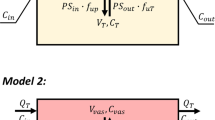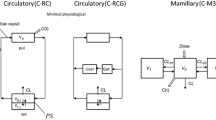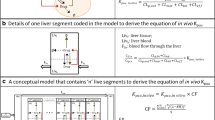Abstract
Theoretical equations are derived to estimate the extent of the hepatic and pulmonary first-pass effect after oral and intraperitoneal administration. This first-pass effect is taken into consideration for the determination of apparent volume of distribution and body clearance. Calculations using data for two normal adult subjects taken from the literature suggest that the fractions of chloroform metabolized in the liver and excreted intact from the lung in the first pass are maximally 0.38 and 0.172. respectively. The apparent volumes of distribution of chloroform in these two subjects are 238 and 283% of their body weight in terms of blood concentration. Close agreement between the predicted and experimental values for the pulmonary excretion clearance is also found.
Similar content being viewed by others
References
P. A. Harris and S. Riegelman. Influence of route of administration on the area under the plasma concentration-time curve.J. Pharm. Sci. 58: 71–75 (1969).
M. Gibaldi and S. Feldman. Pharmacokinetic basis for the influence of route of administration on the area under the plasma concentration-time curve.J. Pharm. Sci. 58: 1477–1480 (1969).
M. Gibaldi, R. N. Boyes, and S. Feldman. Influence of first-pass effect on availability of drug on oral administration.J. Pharm. Sci. 60: 1338–1340 (1971).
D. Perrier and M. Gibaldi. Influence of first-pass effect on the systemic availability of propoxyphene.J. Clin. Pharmacol. 12: 449–452 (1972).
M. Rowland. Influence of route of administration on drug availability.J. Pharm. Sci. 61: 70–74 (1972).
M. Gibaldi and S. Feldman. Route of administration and drug metabolism.Eur. J. Pharmacol. 19: 323–329 (1972).
G. H. Evans and D. G. Shand. Disposition of propranolol. V. Drug accumulation and steady-state concentrations during chronic oral administration in man.Clin. Pharmacol. Ther. 14: 487–493 (1973).
M. Rowland. Effect of some physiologic factors on bioavailability of oral dosage forms. In Swarbrick, J. (ed.),Current Concepts in Pharmaceutical Sciences: Dosage Form Design and Bioavailability, Lea and Febiger, Philadelphia.
S. Riegelman and M. Rowland. Effect of route of administration on drug disposition.J. Pharmacokin. Biopharm. 1: 419–434 (1973).
E. J. Pantuck, K. C. Hsiao, A. Maggio, K. Nakamura, R. Kuntzman, and A. H. Conney. Effect of cigarette smoking on phenacetin metabolism.Clin. Pharmacol. Ther. 15: 9–17 (1974)
P. J. Pentikainen, S. H. Wan, and D. L. Azarnoff. Bioavailability of aminosalicylic acid and its various salts in humans. IV. Comparison of four brands of the sodium salt.J. Pharm. Sci. 63: 1431–1434 (1974).
W. L. Chiou. Dose- and dosage form-dependent pharmacokinetics of phenacetin and its metabolite in man.J. Clin. Pharmacol. 14: 418–425 (1974).
W. L. Chiou. Apparent volume of distribution, pulmonary clearance and bioavailability of volatile or gaseous compounds after peripheral intravenous dosing.Res. Commun. Chem. Pathol. Pharmacol. 7: 679–686 (1974).
S. Niazi and W. L. Chiou. Fluorocarbon aerosol propellants. IV. Pharmacokinetics of trichloromonofluoromethane following single and multiple dosing in dogs.J. Pharm. Sci. 64: 763–769 (1975).
A. Grollman and E. F. Grollman.Pharmacology and Therapeutics, Lea and Febiger, Philadelphia, 1970, pp. 80–81.
J. B. Terrill. Arterial venous blood levels of chloropentafluoroethane: Inhalation versus oral exposures.Am. Ind. Hyg. Assoc. J. 35: 269–275 (1974).
B. J. Fry, T. Taylor, and D. E. Hathway. Pulmonary elimination of chloroform and its metabolite in man.Arch. Int. Pharmacodyn. 196: 98–111 (1972).
A. C. Guyton.Textbook of Medical Physiology, 4th ed., Saunders, Philadelphia, 1971, pp. 311 and 369.
Author information
Authors and Affiliations
Rights and permissions
About this article
Cite this article
Chiou, W.L. Quantitation of hepatic and pulmonary first-pass effect and its implications in pharmacokinetic study. I. Pharmacokinetics of chloroform in man. Journal of Pharmacokinetics and Biopharmaceutics 3, 193–201 (1975). https://doi.org/10.1007/BF01067908
Received:
Revised:
Published:
Issue Date:
DOI: https://doi.org/10.1007/BF01067908




